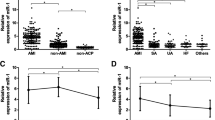Abstract
Background
Ischemic heart disease is the single most common cause of death worldwide. In order to increase the accuracy of the diagnosis, new diagnostic methods have been introduced, including miRNA-499, which is a promising biomarkers in coronary atherosclerotic diseases (CAD), and acute myocardial infarction (AMI).
Aim of the work
To evaluate the diagnostic value of circulating miRNA-499 versus high-sensitivity cardiac troponin in early diagnosis of AMI with ST segment elevation within the first 6 h of complaint.
Subjects and methods
This study was conducted on 100 Egyptian patients who presented during the first 3 h of AMI in the emergency department and 98 healthy volunteers as a control group. Serum samples for both groups were analyzed using reverse transcription and real-time PCR by TaqMan® MicroRNA assays.
Results
The concentration of miRNA-499 was significantly elevated in STEMI patients compared to healthy controls (p < 0.001). Moreover, receiver operating characteristic (ROC) curve analysis showed that area under the curve (AUC) for miRNA-499 was 0.90 (95% CI, 0.845–0.955) with 89% sensitivity and 83% specificity, at which positive predictive value (PPV) was 94% andnegative predictive value (NPV) was 69%. Furthermore, miRNA-499 displayed significant positive correlation with hs-cTnT and higher expression than hs-cTnT in the first 3 h of chest pain in emergency department.
Conclusion
miRNA-499 is a promising reliable biomarker for early detection of STEMI patients.

Similar content being viewed by others
Data availability
The datasets used and analyzed during the current study are available from the corresponding author on reasonable request.
References
Boon RA, Dimmeler S (2015) MicroRNAs in myocardial infarction. Nat Rev Cardiol. 12(3):135–142
Boštjančič E (2014) miRNome in myocardial infarction: Future directions and perspective. World J Cardiol 6(9):939
Chen C, Ridzon DA, Broomer AJ, Zhou Z, Lee DH, Nguyen JT, et al. Real-time quantification of microRNAs by stem-loop RT-PCR. Nucleic Acids Res. 2005;33(20).
Cheng C, Wang Q, You W, Chen M, Xia J. MiRNAs as biomarkers of myocardial infarction: a meta-analysis. PLoS One. 2014;9(2).
Condorelli G, Latronico MVG, Dorn GW (2010) MicroRNAs in heart disease: putative novel therapeutic targets? Eur Heart J. 31(6):649–658
Creemers EE, Tijsen AJ, Pinto YM (2012) Circulating MicroRNAs: novel biomarkers and extracellular communicators in cardiovascular disease? Circ Res. 110(3):483–495
Devaux Y, Mueller M, Haaf P, Goretti E, Twerenbold R, Zangrando J, Vausort M, Reichlin T, Wildi K, Moehring B, Wagner DR, Mueller C (2015) Diagnostic and prognostic value of circulating microRNAs in patients with acute chest pain. J Intern Med. 277(2):260–271. https://doi.org/10.1111/joim.12183
Feinberg MW, Moore KJ (2016) MicroRNA regulation of atherosclerosis. Circ Res. 118(4):703–720
Li YQ, Zhang MF, Wen HY, Hu CL, Liu R, Wei HY, Ai CM, Wang G, Liao XX, Li X (2013) Comparing the diagnostic values of circulating microRNAs and cardiac troponin T in patients with acute myocardial infarction. Clinics. 68(1):75–80
miRNAeasy® mini kit protocol.2013: Principle of enrichment procedure for small RNAs. www.qiagen.com.
Navickas R, Gal D, Laucevičius A, Taparauskaite A, Zdanyte M, Holvoet P (2016) Identifying circulating microRNAs as biomarkers of cardiovascular disease: A systematic review. Cardiovasc Res. 111(4):322–337
Sayed ASM, Xia K, Yang TL, Peng J (2013) Circulating microRNAs: a potential role in diagnosis and prognosis of acute myocardial infarction. Dis Markers. 35(5):561–566
Shalaby SM, El-Shal AS, Shoukry A, Khedr MH, Abdelraheim N (2016) Serum miRNA-499 and miRNA-210: a potential role in early diagnosis of acute coronary syndrome. IUBMB Life. 2:673–682
Xin Y, Yang C, Han Z (2016) Circulating miR-499 as a potential biomarker for acute myocardial infarction. Ann Transl Med. 4(7):7–10
Zhang L, Chen X, Su T, Li H, Huang Q, Wu D, Yang C, Han Z (2015) Circulating miR-499 are novel and sensitive biomarker of acute myocardial infarction. J Thorac Dis. 7(3):303–308
Zhao CH, Cheng GC, He RL, Hong Y, Wan QL, Wang ZZ, Pan ZY (2015) Analysis and clinical signifcance of microRNA-499 expression levels in serum of patients with acute myocardial infarction. Genet Mol Res. 14(2):4027–4034. https://doi.org/10.4238/2015.April.27.17
Acknowledgments
All authors are very grateful to the patients and the volunteer control individuals who participated in this study, and also to all members of Cardiology Department and Clinical and Chemical Pathology Department, Cairo University, and particularly the staff members of catheterization laboratory for their help in completing this work.
Author information
Authors and Affiliations
Contributions
DMA did the practical work, collected, analyzed and interpreted the patient data and was a major contributor in writing the manuscript. EFA revised the data set. YSK was responsible for sample collection according to the inclusion criteria, and sample storage according to the methodology protocol. HST revised the data set and designed the antiviral treatment protocol. All authors read and approved the final manuscript.
Corresponding author
Ethics declarations
Ethics approval and consent to participate
Approval was obtained from Cardiology Department Council of Cairo University. All procedures performed in the study were under the ethical standards of the Kasr Al-Ainy School of Medicine and with the 1964 Helsinki declaration and its later amendments or comparable ethical standards. All the procedures were approved by the ethical committee of the Kasr Al-Ainy School of Medicine, and written informed consent was obtained from each participant after a full explanation of the study protocol. All procedures, including individual data, were treated with confidentiality.
Consent for publication
Not applicable.
Competing interests
The authors declare no competing interests.
Additional information
Publisher’s note
Springer Nature remains neutral with regard to jurisdictional claims in published maps and institutional affiliations.
Supplementary Information
ESM 1
(XLSX 44.8 kb)
Rights and permissions
About this article
Cite this article
Abdou, D.M., Aziz, E.E., Kazem, Y.S. et al. The diagnostic value of circulating microRNA-499 versus high-sensitivity cardiac troponin T in early diagnosis of ST segment elevation myocardial infarction. Comp Clin Pathol 30, 565–570 (2021). https://doi.org/10.1007/s00580-021-03204-5
Received:
Accepted:
Published:
Issue Date:
DOI: https://doi.org/10.1007/s00580-021-03204-5




